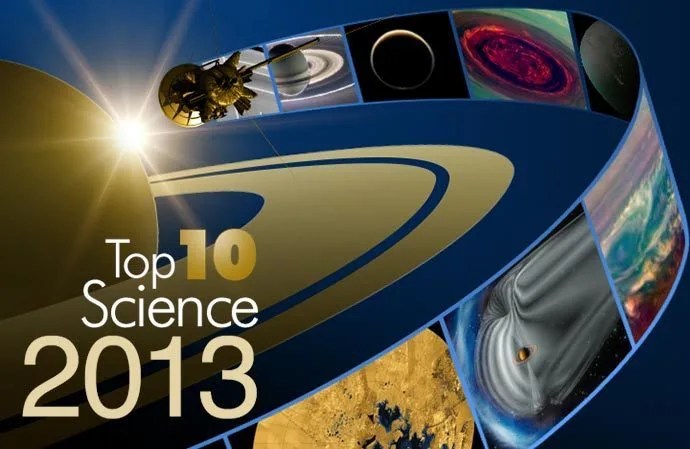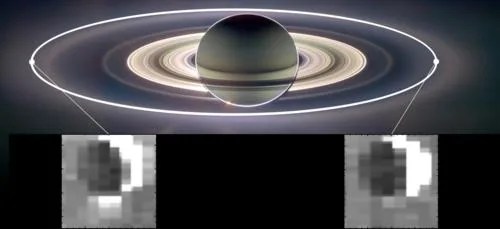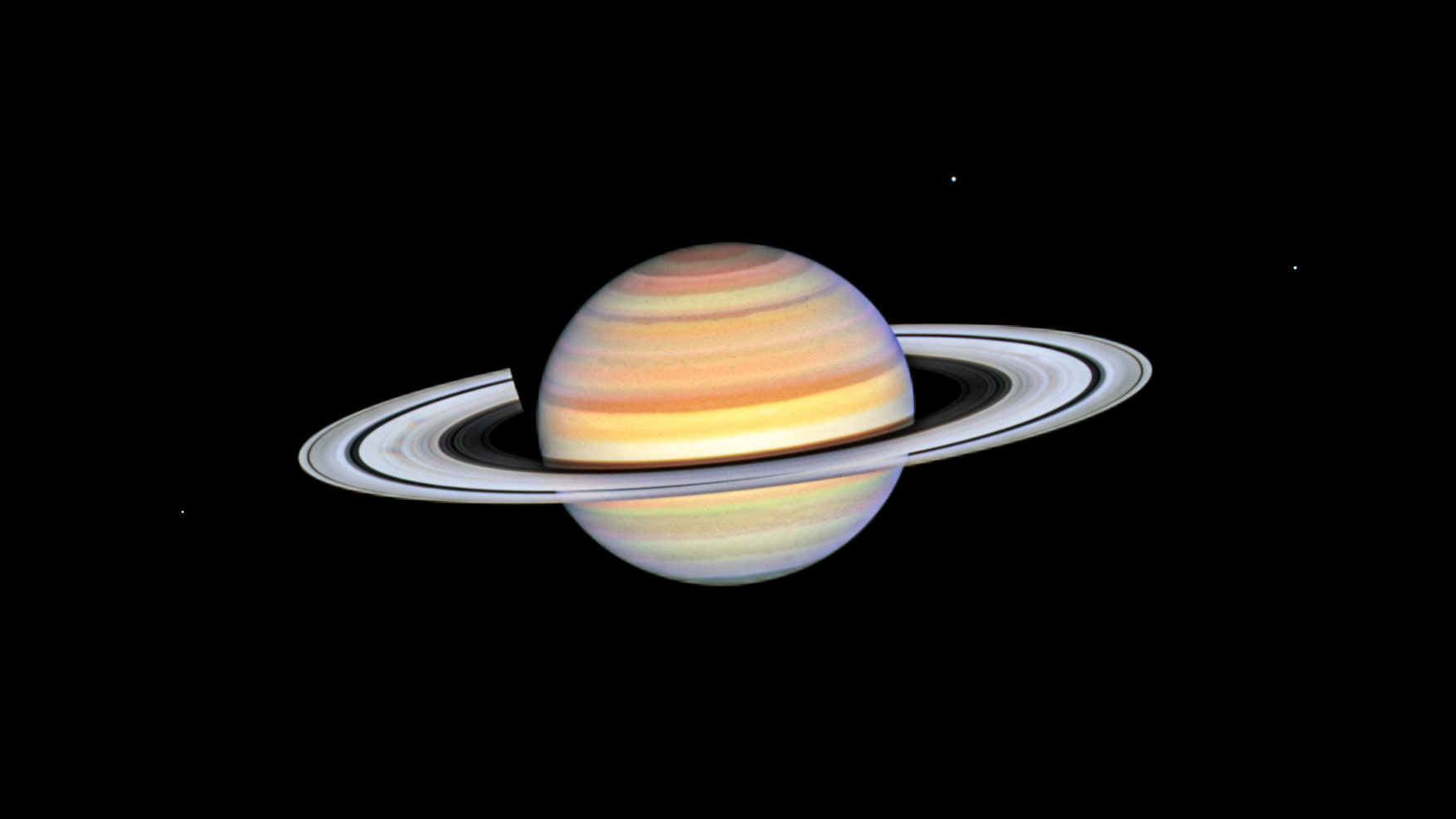7 min read

As Cassini nears its 10th anniversary of exploring Saturn, fresh insights and new revelations continue to amaze. Researchers use the data streaming back from Cassini to improve our understanding of not only the Saturn system, but of processes that influence the formation of planets, rings and moons everywhere. This list is the Cassini team’s top picks for the mission’s 10 most interesting science findings of 2013.
- First Determination of Depth of a Titan Sea
- Saturn’s Gravity Controls Enceladus’ Jets
- Ring Impact Clouds
- Discovery of Saturn’s North Polar Hurricane
- Titan’s Northern Hemisphere Revealed
- “Supernova-like” Shocks… at Saturn
- Discovery of Propylene in Titan’s Atmosphere
- Rings as a Giant Saturnian Seismograph
- Haze Formation in Titan’s Atmosphere
- Saturn’s Great Northern Storm Results

This colorized mosaic shows the most complete view yet of Titan's northern land of lakes and seas. Saturn's moon Titan is the only world in our solar system other than Earth that has stable liquid on its surface. The liquid in Titan's lakes and seas is mostly methane and ethane.
- RADAR data revealed that Ligeia Mare (Titan’s second-largest sea) is about 560 feet (170 meters) deep using a creative technique previously used to analyze Mars data.
- This is the first time scientists have been able to plumb the bottom of a lake or sea on Titan. This was possible partly because the liquid turned out to be mostly methane, allowing the radar signal to pass through it easily.
- The liquid surface may be as smooth as the paint on our cars, and it is very clear to radar eyes.
- Nearly all of the lakes (97%) on Titan fall into an area covering about 600 miles by 1,100 miles (900 kilometers by 1,800 kilometers). Titan’s lakes may lay on top of a hydrocarbon aquifer.

Enceladus’ jets are most powerful when the moon is farthest away from Saturn in its orbit (inset image on the left, jets at bottom), and weakest when it is closest to Saturn (right).
- The brightness of Enceladus’ jets changes by a factor of three to four, approximately the same as moving from a dim hallway to a brightly lit office.
- About 200 pounds (about 100 kilograms) of water ice per second – about as much as an active comet – spray out from long cracks in the south polar region known as "tiger stripes." Some of the ejected material forms the E-ring.
- Enceladus has the most spray when orbiting farthest from Saturn (inset image on the left; jets are at the bottom) and the least spray when it is closest to Saturn (inset image on the right).
- Scientists think fissures are squeezed shut when the moon is feeling the greatest force of Saturn's gravity. Farther from Saturn, lower gravitational force allows the fissures to open and release the spray.

Five images of Saturn's rings, taken between 2009 and 2012, show clouds of material ejected from impacts of small objects into the rings. Clockwise from top left are two views of one cloud in the A ring, taken 24.5 hours apart, a cloud in the C ring, one in the B ring, and another in the C ring.
- First direct evidence of small meteoroids breaking into streams of rubble and crashing into Saturn's rings.
- The meteoroids detected by Cassini were comparable in size to the meteor that hurtled over Chelyabinsk, Russia, in February 2013. Meteoroids of this size probably break up on a first encounter with the rings, creating smaller, slower pieces that then enter into orbit around Saturn. Clouds are kicked up when these secondary meteoroid pieces impact the rings. The tiny particles forming these clouds have a range of orbital speeds around Saturn that pull them into diagonal, extended bright streaks.
- These observations make Saturn's rings the only location besides Earth, the moon, and Jupiter where scientists and amateur astronomers have been able to observe impacts as they occur. Studying the impact rate of meteoroids helps scientists understand how planets and moons in our solar system formed.

The spinning vortex of Saturn's north polar storm resembles a deep red rose of giant proportions surrounded by green foliage in this false-color image. Measurements have sized the eye at a staggering 1,250 miles (2,000 kilometers) across with cloud speeds as fast as 330 miles per hour (150 meters per second).
- Cassini has captured the first close-up, visible-light views of a behemoth hurricane swirling around Saturn's north pole.
- Somewhat similar to hurricanes on Earth, the Saturn hurricane is much larger and spins surprisingly fast. The eye is about 50 times the size of the average hurricane eye on Earth; the wind in the eye wall blows more than four times faster than hurricane-force winds on Earth. Unlike terrestrial hurricanes, which tend to move, the Saturnian hurricane is locked onto the planet's north pole.
- Learning how these Saturnian storms use water vapor could tell scientists more about how terrestrial hurricanes are generated and sustained.

Titan is the only place in the solar system other than Earth that we know has stable liquid on its surface, though its lakes are made of liquid ethane and methane rather than liquid water.
- Better spacecraft vantages, the rising sun in the north, and sunlight burning off polar hazes combine to provide scientists with their best near-infrared views of the liquid methane and ethane seas and lakes that reside near Titan's north pole.
- This false-color mosaic highlights variations in the composition of surface materials around hydrocarbon lakes on Titan, Saturn's largest moon. Orange areas are thought to be evaporite – Titan’s equivalent of salt flats on Earth. Evaporated material may be organic chemicals originally from Titan's haze particles that once were dissolved in liquid methane. Titan's typical bedrock of water ice is colored green.

This artist's impression shows Cassini exploring the magnetic environment of Saturn. The image is not to scale. Saturn's magnetosphere is depicted in grey, while the complex bow shock region -- the shock wave in the solar wind that surrounds the magnetosphere -- is shown in blue.
- During a chance encounter with what appears to be an unusually strong blast of solar wind at Saturn, Cassini detected particles being accelerated to ultra-high energies with speeds approaching the speed of light.
- This is similar to the acceleration of particles that takes place around distant supernovas, a source of cosmic rays. The shockwave that forms from the flow of solar wind around Saturn's magnetic field provides a rare laboratory for scientists to observe the phenomenon of far-off stellar explosions up-close.

Cassini looks toward the night side of Saturn's largest moon and sees sunlight scattering through Titan's atmosphere, forming a ring of color.
- Cassini has detected propylene, a chemical used to make food-storage containers, car bumpers and other consumer products, on Saturn's moon Titan. This is the first definitive detection of the plastic ingredient on any moon or planet, other than Earth.
- Detection of this molecule fills in a mysterious gap in Titan observations that dates back to NASA's Voyager 1 spacecraft and the first-ever close flyby of this moon in 1980. Previously, Voyager found propane, the heaviest member of the three-carbon family, and propyne, one of the lightest members. However the “middleweight” chemicals, one of which is propylene, were missing.

Cassini scientists have discovered that Saturn's rings act as a seismograph that records large-scale oscillations.
- Many patterns in Saturn’s rings are caused by the tug of the planet’s moons. Other ring patterns couldn’t be as easily explained.
- Ring scientists have found that the cause of these patterns is Saturn itself. The planet naturally vibrates, like a bell, with periods of a few hours. The variation in gravity caused by these oscillations tugs on ring particles, causing a ripple. Thus, the rings become a natural seismograph.
- Just like earthquakes and solar oscillations can probe the interiors of the Earth and the sun, Saturn’s vibrations can be used to help scientists understand the internal structure of the giant planets.

The various steps that lead to the formation of the aerosols that make up the haze on Titan, Saturn's largest moon.
- Cassini has confirmed the presence of a population of large, complex hydrocarbons in the upper atmosphere of Saturn's largest moon, Titan, that later evolve into the components that give the moon a distinctive orange-brown haze.
- When sunlight or highly energetic particles from Saturn's magnetic bubble hit the upper layers of Titan's atmosphere, they break up nitrogen and methane molecules. This triggers a chain of chemical reactions that eventually produce large hydrocarbons. Earth’s smog starts in a similar way, with sunlight breaking up small hydrocarbons that are emitted into the air to form more complex hydrocarbons.
- These reactions eventually lead to the production of carbon-based aerosols that drift downward to form the lower layers of the haze that enshrouds Titan

This set of images from NASA's Cassini mission shows the evolution of a massive thunder-and-lightning storm that circled all the way around Saturn and fizzled when it ran into its own tail.
- Cassini’s near infrared camera found a combination of water and ammonia ice in Saturn’s Great Northern Storm clouds. This was the first detection of water ice on Saturn.
- First detected on Dec. 5, 2010, and tracked by Cassini's imaging cameras and radio and plasma wave subsystem, the storm had erupted at about 33 degrees north latitude.
- Shortly after the bright, turbulent head of the storm emerged and started moving west, it spawned a clockwise-spinning vortex that drifted much more slowly. Within months, the storm wrapped around the planet, stretching about 190,000 miles (300,000 kilometers), thundering and throwing lightning along the way. By Aug. 28, after 267 days, the Saturn storm stopped thundering for good.
Share
Details
Last Updated
Jan 24, 2024
Editor
NASA Science Editorial Team
Related Terms
Keep Exploring







